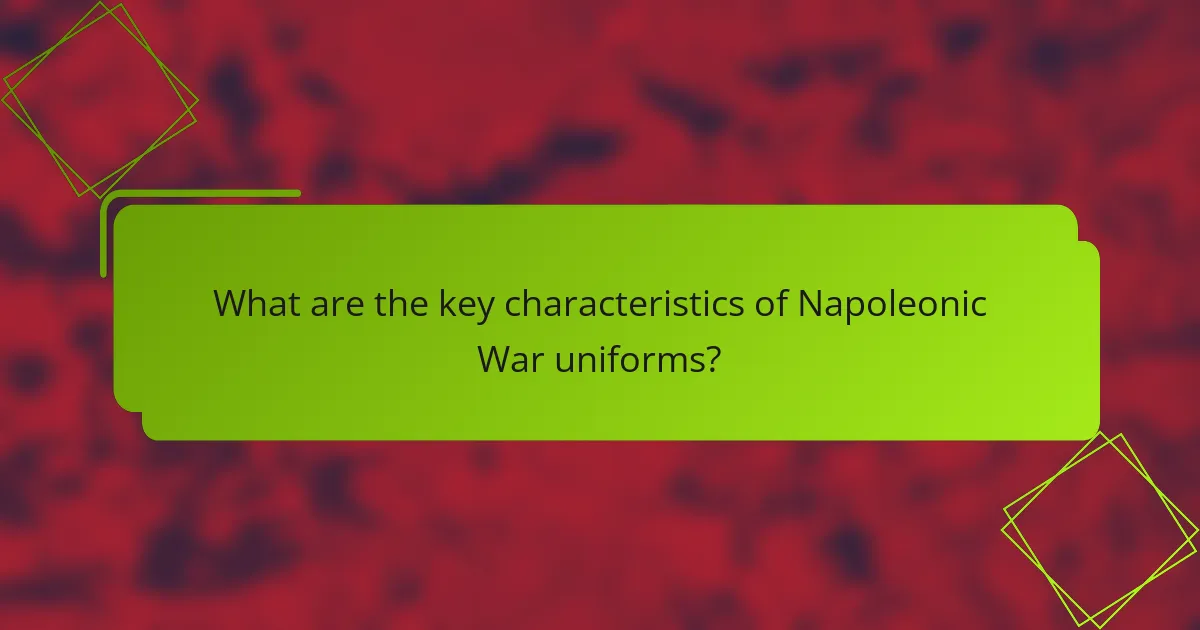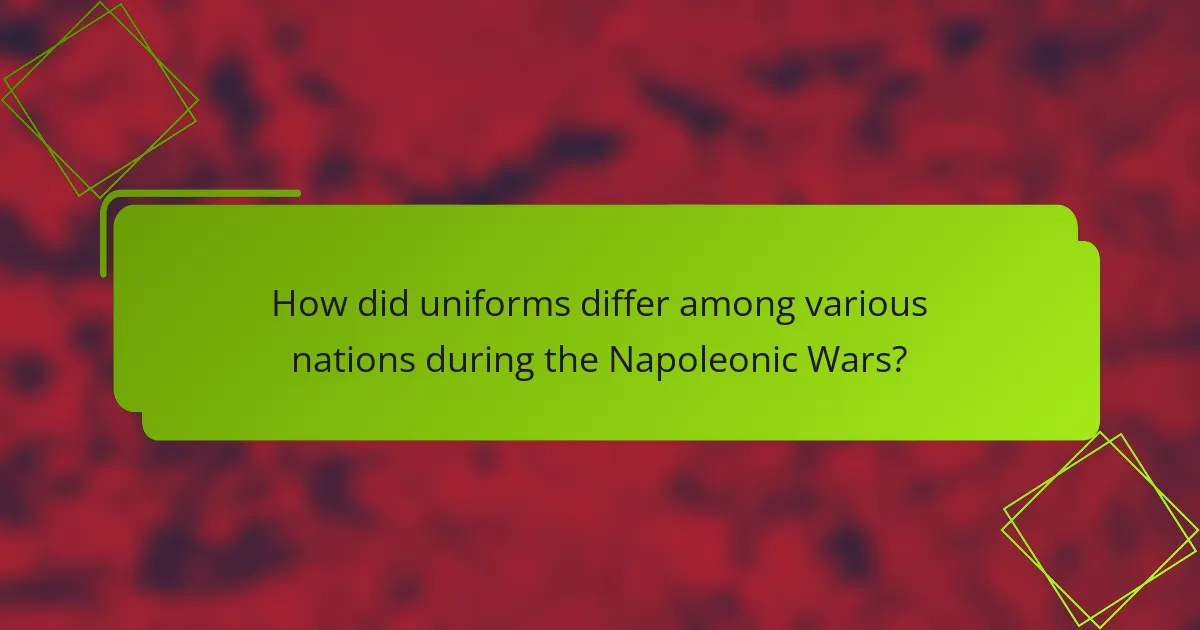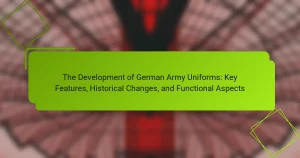Napoleonic War uniforms are defined by their distinctive colors, elaborate designs, and specific military insignia, reflecting national pride and military hierarchy. These uniforms varied among nations, with the British army wearing red, French soldiers in blue, Austrian troops in white, and Russian soldiers in green, each color symbolizing unique historical and cultural identities. The evolution of these uniforms prioritized practicality, comfort, and visibility, utilizing durable materials like wool and cotton to withstand diverse combat conditions. Additionally, the design facilitated quick identification of ranks and regiments, reinforcing unity and morale among troops during the Napoleonic Wars.

What are the key characteristics of Napoleonic War uniforms?
Napoleonic War uniforms are characterized by their distinctive colors, elaborate designs, and specific military insignia. The uniforms typically featured bright colors, such as blue, red, and white, symbolizing national pride. Tailoring was precise, with fitted jackets and trousers that allowed for ease of movement. Epaulettes and sashes were common, denoting rank and unit affiliation. Additionally, the use of unique headgear, like bicorne hats, distinguished officers from enlisted men. The materials used included wool and cotton, providing durability and comfort. These uniforms not only served practical purposes but also conveyed the military’s hierarchy and discipline. Historical records show that these uniforms were designed to instill a sense of unity and morale among troops.
How did the design of Napoleonic War uniforms evolve over time?
The design of Napoleonic War uniforms evolved significantly from 1796 to 1815. Initially, uniforms were heavily influenced by the styles of the French Revolutionary Army. They featured bright colors and elaborate designs. Over time, practicality became more important. By the early 1800s, uniforms became simpler and more functional. They incorporated elements like shorter coats and less ornamentation. The introduction of standardized patterns helped unify military appearance. Fabrics transitioned from ornate materials to more durable options. This evolution reflected changing military needs and social attitudes towards warfare.
What influences shaped the early designs of these uniforms?
Early designs of Napoleonic War uniforms were influenced by military tradition, practicality, and the desire for visual distinction. Military tradition dictated specific color schemes and styles, rooted in previous conflicts. Practicality was essential for functionality in battle, impacting fabric choices and cuts. The desire for visual distinction led to elaborate embellishments and unique insignias. These factors combined to create uniforms that were both practical and symbolically representative of the military hierarchy. Historical records indicate that the French army adopted these elements to project power and unity during the Napoleonic Wars.
How did military strategies impact uniform design during the Napoleonic Wars?
Military strategies significantly influenced uniform design during the Napoleonic Wars. The need for visibility on the battlefield led to the adoption of bright colors and distinctive patterns. This helped in identifying units quickly during combat. Additionally, the emphasis on mobility and rapid maneuvers prompted the use of lighter materials. Soldiers required uniforms that allowed for greater freedom of movement. The strategic focus on massed formations also influenced the cut and fit of uniforms. Tailored designs facilitated easier movement in tight formations. Furthermore, military strategies necessitated the inclusion of functional elements, such as pockets and epaulettes, for practical use. These adaptations reflected the evolving nature of warfare during this period.
What materials were commonly used in Napoleonic War uniforms?
Napoleonic War uniforms were commonly made from wool, cotton, and linen. Wool was the primary fabric due to its durability and warmth. It was often used for the outer garments like coats and trousers. Cotton was utilized for lighter uniforms and shirts, providing breathability. Linen was also employed, particularly in summer uniforms, for its lightweight properties. These materials were chosen for their practicality in various climates and conditions faced during the war. Historical records indicate that the British Army, for instance, predominantly used wool for their uniforms, while the French Army incorporated cotton and linen as well.
How did the choice of materials affect the functionality of the uniforms?
The choice of materials significantly influenced the functionality of Napoleonic War uniforms. Wool was commonly used for its durability and warmth, essential for soldiers in various climates. Cotton provided breathability, improving comfort during long marches. The use of linen in summer uniforms offered lightweight options, enhancing mobility. Additionally, the incorporation of leather for boots and belts ensured protection and support. The blend of these materials allowed for practical adaptations to different environments. Historical records indicate that the choice of materials directly impacted soldiers’ performance and endurance in the field.
What were the sources of these materials during the Napoleonic era?
The sources of materials during the Napoleonic era included local and imported textiles. Wool was primarily sourced from British and French sheep. Linen was often derived from flax grown in Europe. Cotton was imported from colonies, especially from India. Silk was mainly sourced from Italy and France. Leather was obtained from local tanneries across Europe. Metal components like buttons and insignia were produced in local workshops. These sources ensured a diverse range of materials for military uniforms. The availability of these materials influenced the design and functionality of the uniforms worn during the Napoleonic Wars.
What symbolism is associated with Napoleonic War uniforms?
Napoleonic War uniforms symbolize national pride, military hierarchy, and the power of the state. The colors and designs represented the identity of different regiments. For example, the French army often used blue, which became synonymous with their military. Uniforms also displayed rank through distinct insignias and decorations. This visual hierarchy reinforced discipline and order within the ranks. Additionally, the elaborate designs aimed to intimidate opponents and inspire troops. The use of specific materials reflected the resources and technology of the time. Overall, these uniforms served both functional and symbolic purposes in warfare.
How did colors and insignia convey rank and unit identity?
Colors and insignia conveyed rank and unit identity by providing visual cues that differentiated soldiers. Bright colors indicated specific regiments, enhancing unit recognition on the battlefield. For example, the British army used red for infantry, while the French favored blue. Insignia, such as badges and epaulettes, represented rank, indicating hierarchy among soldiers. Higher ranks had more elaborate insignia, making their status clear. This system allowed for quick identification during combat. Historical records show that these visual elements played a crucial role in maintaining order and discipline in military formations.
What cultural or historical meanings were attached to specific uniform features?
Uniform features of the Napoleonic War era held significant cultural and historical meanings. Colors often represented national identity; for instance, the French army predominantly wore blue, symbolizing loyalty and unity. Epaulettes indicated rank and authority, distinguishing officers from enlisted men. The cut of the uniform reflected social status; tailored designs signified wealth and military prestige. Patterns, such as the use of lace, conveyed cultural sophistication and adherence to military tradition. Specific insignias denoted regimental affiliation, fostering a sense of belonging among soldiers. Overall, these features were carefully designed to reflect the values and hierarchy of the time.

How did uniforms differ among various nations during the Napoleonic Wars?
Uniforms during the Napoleonic Wars varied significantly among nations. The British army wore red tunics, symbolizing their military heritage. French soldiers donned blue coats, reflecting national pride and revolutionary ideals. Austrian troops sported white uniforms, which were practical for the diverse terrain of their empire. Russian soldiers typically wore green, suitable for camouflage in their vast landscapes. Each nation’s uniform design also included distinct insignias, buttons, and headgear, which indicated rank and unit. The use of specific colors and styles was often driven by historical traditions and the desire to instill national identity. These differences played a crucial role in military strategy and morale during the conflicts.
What were the unique design features of British uniforms?
British uniforms during the Napoleonic Wars featured distinct design elements. They were characterized by their bright red coats, which symbolized bravery and made soldiers easily identifiable. The uniforms often included intricate lace and gold embellishments, showcasing rank and regiment. Tailcoats were tailored with a cutaway front, allowing for ease of movement. Trousers or breeches were typically worn, with some regiments opting for white or blue colors. Additionally, distinctive headgear like bearskin caps or bicorn hats were common, enhancing the visual impact of the troops. These design features were not only functional but also served to boost morale and convey a sense of tradition.
How did British military traditions influence uniform styles?
British military traditions significantly influenced uniform styles by establishing distinctive design elements and color schemes. The iconic red coat became a symbol of British infantry during the 18th and 19th centuries. This choice of color was practical for visibility on the battlefield and instilled a sense of unity among troops.
Additionally, the use of elaborate decorations, such as lace and embroidery, was derived from ceremonial practices. These embellishments reflected the status of different regiments. The adoption of specific insignia and badges further personalized uniforms, denoting rank and unit affiliation.
British military traditions also emphasized the importance of tailoring and fit, leading to uniforms that were not only functional but also aesthetically pleasing. The influence of these traditions can be seen in the structured designs that characterized uniforms during the Napoleonic Wars.
Overall, British military traditions shaped the evolution of uniform styles through color choices, design details, and a focus on craftsmanship.
What distinguished French uniforms from those of other nations?
French uniforms were distinguished by their vibrant colors and elaborate designs. They often featured bold blue coats, which symbolized loyalty and valor. The use of intricate gold and silver embroidery was common, showcasing military rank and unit affiliation. French uniforms also included distinctive headgear, such as bicornes and shakos, which set them apart visually. The cut of the uniforms emphasized both functionality and style, allowing for ease of movement. Additionally, the French military adopted unique insignia that reflected their revolutionary ideals. This combination of elements created a recognizable and iconic aesthetic that differed from the more subdued uniforms of other nations.
How did Napoleon’s vision influence the French uniform design?
Napoleon’s vision significantly influenced French uniform design by emphasizing a combination of practicality and grandeur. He sought uniforms that were both functional for military operations and visually striking to instill pride and discipline. The introduction of the iconic bicorne hat and tailored coats exemplified this dual focus. The colors red and blue were standardized to symbolize loyalty and valor. Napoleon also mandated the use of epaulettes to denote rank, enhancing the hierarchical structure within the army. His vision aimed to unify the appearance of soldiers, fostering a sense of identity and cohesion. The designs were intended to reflect the power of the French Empire, making the army visually impressive on the battlefield. This strategic approach to uniform design not only influenced military attire but also set a precedent for future military fashion in Europe.
What were the key characteristics of uniforms from other countries involved?
Key characteristics of uniforms from other countries involved in the Napoleonic Wars included distinctive colors and styles. For instance, British uniforms featured red coats with white facings. French soldiers wore blue coats, symbolizing their revolutionary ideals. Prussian uniforms were characterized by their dark blue color and unique pickelhaube helmets. Russian troops donned green and brown uniforms, reflecting their tactical needs. Austrian uniforms were notable for their white and grey color schemes. Each country’s uniform design served both practical and symbolic purposes, representing national identity and military tradition.
How did alliances and rivalries impact uniform design across nations?
Alliances and rivalries significantly influenced uniform design across nations during the Napoleonic Wars. Nations often adopted similar colors and styles to signify alliances. For example, the French and their allies utilized blue uniforms, which became a symbol of their coalition. Conversely, rival nations like Britain and Austria developed distinct designs to differentiate themselves. The British army, for instance, maintained its iconic red coats to establish a unique identity. Additionally, uniforms served as a means of psychological warfare, with distinctive designs intended to intimidate opponents. The desire for unity among allies led to shared design elements, while competition among rivals encouraged innovation and differentiation. Historical records indicate that these design choices were deliberate strategies to enhance morale and cohesion within forces.

What practical considerations influenced the evolution of Napoleonic War uniforms?
The evolution of Napoleonic War uniforms was influenced by practicality in combat and logistics. These uniforms needed to provide comfort and mobility for soldiers during long campaigns. The materials used were selected for durability and ease of maintenance. Wool was commonly used for its warmth and resilience, while cotton offered breathability in warmer climates.
Additionally, uniforms were designed for quick identification of ranks and regiments. Bright colors and distinctive patterns helped with visibility on the battlefield. The cut of the uniforms allowed for ease of movement, which was essential in combat situations.
Weather conditions also played a role in uniform design. Soldiers required clothing that could withstand various environments, leading to adaptations in fabric and layering.
Finally, the need for uniforms to be mass-produced influenced their design. Standardized patterns and materials facilitated quicker manufacturing and reduced costs. These practical considerations collectively shaped the uniforms worn during the Napoleonic Wars.
How did climate and terrain affect uniform design choices?
Climate and terrain significantly influenced uniform design choices during the Napoleonic Wars. In colder climates, uniforms featured heavier materials for insulation, like wool. This choice provided warmth to soldiers in harsh weather conditions. Conversely, in warmer regions, lighter fabrics such as linen were preferred. These materials allowed for better ventilation and comfort in high temperatures.
Terrain also played a critical role. Troops in mountainous areas required durable uniforms that could withstand rugged conditions. This led to the incorporation of reinforced stitching and practical designs. Additionally, colors were chosen based on the environment. For example, earth tones helped soldiers blend into the landscape, providing camouflage.
Historical records indicate that these adaptations were essential for maintaining soldier effectiveness and morale. The design of uniforms was thus a direct response to the challenges posed by climate and terrain during military campaigns.
What adaptations were made for soldiers in different environments?
Soldiers in different environments had uniforms adapted for climate and terrain. For tropical regions, lighter fabrics and short-sleeved designs were used to enhance breathability. In colder climates, heavier wool materials provided insulation and warmth. Soldiers in mountainous areas received uniforms designed for mobility and flexibility. Specific adaptations included reinforced seams and durable materials for rugged conditions. These changes were essential for maintaining soldier effectiveness and comfort in diverse environments. Historical records indicate that such adaptations were critical for operational success during the Napoleonic Wars.
What role did uniform maintenance and durability play in design decisions?
Uniform maintenance and durability were critical factors in the design decisions of Napoleonic War uniforms. These aspects ensured that uniforms could withstand the rigors of battle and the elements. Durable materials were chosen to prevent rapid wear and tear. This choice extended the lifespan of the uniforms, reducing the need for frequent replacements. Maintenance considerations influenced the complexity of designs. Simpler designs allowed for easier cleaning and repairs. Historical accounts indicate that soldiers often faced harsh conditions, making durability essential. The use of wool and sturdy fabrics was prevalent for their resilience. Ultimately, these factors shaped uniforms that balanced functionality with military aesthetics.
How did the need for practicality influence material selection?
The need for practicality significantly influenced material selection in Napoleonic War uniforms. Military uniforms required durability to withstand harsh conditions. Fabrics like wool were favored for their resilience and warmth. Cotton was also used for lighter garments suitable for warmer climates. The choice of materials aimed to ensure comfort during long campaigns. Additionally, practicality dictated the use of colors that concealed dirt and wear. This selection process was crucial for maintaining the soldiers’ effectiveness in battle. Historical records indicate that these choices directly impacted soldiers’ performance and morale.
What lessons can be learned from the evolution of Napoleonic War uniforms?
The evolution of Napoleonic War uniforms teaches lessons about military identity and adaptability. Uniforms reflected the changing nature of warfare and societal values. Initially, bright colors signified rank and unit affiliation. Over time, practicality and camouflage became more important. The shift to darker colors improved soldier safety and effectiveness in battle. Additionally, uniforms served as a tool for propaganda and morale. They created a sense of unity among troops. This evolution illustrates how military attire can influence both function and perception in warfare.
How can modern military uniforms benefit from historical insights?
Modern military uniforms can benefit from historical insights by incorporating functional design elements and symbolism from past conflicts. Historical uniforms, such as those from the Napoleonic Wars, showcased practical features like tailored fits and durable materials. These aspects enhanced mobility and comfort for soldiers in the field.
Additionally, studying historical color schemes and insignias can provide insights into effective identification and morale-boosting symbolism. For instance, the use of certain colors can convey unit pride and heritage. Historical insights also highlight the evolution of protective gear, emphasizing the importance of adapting materials for modern combat scenarios.
By analyzing the successes and failures of past uniforms, modern military designers can create uniforms that balance tradition with contemporary needs. This approach can lead to improved functionality, enhanced soldier identity, and increased operational effectiveness.
The main entity of the article is Napoleonic War uniforms, which are explored in terms of their design features, materials, and symbolism. The article discusses the key characteristics of these uniforms, including their vibrant colors, intricate designs, and military insignia that conveyed rank and unit identity. It examines the evolution of uniform design from 1796 to 1815, influenced by military strategies, practicality, and cultural significance. Additionally, the article highlights the materials used, their sources, and the impact of climate and terrain on uniform functionality, ultimately illustrating how these elements contributed to military identity and effectiveness during the Napoleonic Wars.




